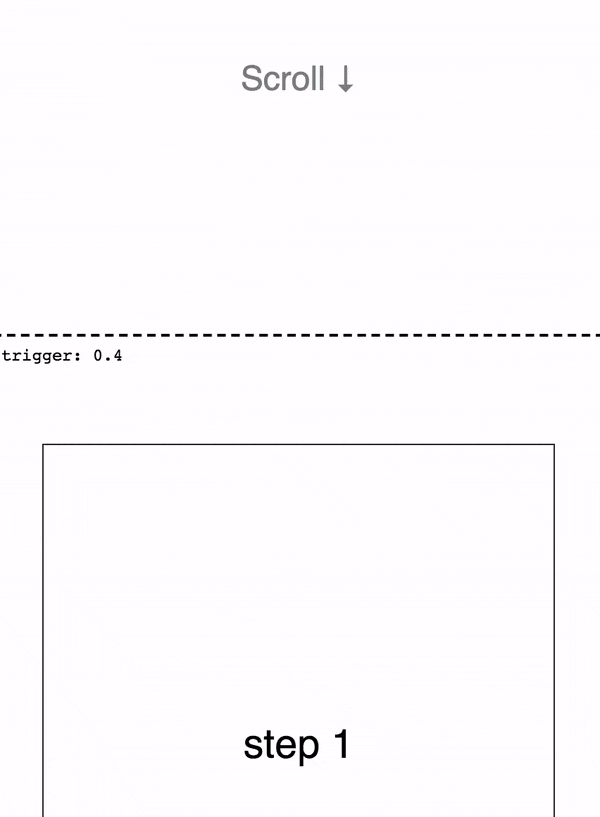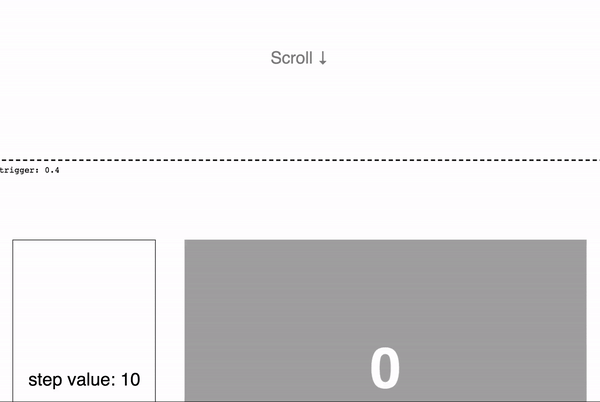React Scrollama is a lightweight interface for scrollytelling in React. It is adapted from Russel Goldenbeg's Scrollama, and it uses the IntersectionObserver instead of scroll events.
As seen in:
  17 interactive visualization stories using React Scrollama for scrollytelling |

|
 The scramble to secure America’s voting machines by Beatrice Jin |

|
 Sex Diversity Among Grad Students is Stagnating by Jason Kao |

|
Take a look at the live demo, presented at ReactNYC.
| Basic step triggers | Sticky graphic on the side |
|---|---|
 |
 |
React Scrollama can be installed as an npm package:
$ npm install react-scrollama
Note: As of version 2.2.0, the IntersectionObserver polyfill has been removed from the build. You must include it yourself for cross-browser support. Check here to see if you need to include the polyfill.
A Scrollama component wraps a set of steps. Each Step component must wrap a DOM element.
<Scrollama onStepEnter={callback}>
<Step data={1}>
<div>...</div>
</Step>
<Step data={2}>
<div>...</div>
</Step>
</Scrollama><Scrollama> provides an interface for listening in on scroll triggers like entering or exiting a step. (Here's a full list of available props.)
A no-frills example:
import React, { useState } from 'react';
import { Scrollama, Step } from 'react-scrollama';
const ScrollamaDemo = () => {
const [currentStepIndex, setCurrentStepIndex] = useState(null);
// This callback fires when a Step hits the offset threshold. It receives the
// data prop of the step, which in this demo stores the index of the step.
const onStepEnter = ({ data }) => {
setCurrentStepIndex(data);
};
return (
<div style={{ margin: '50vh 0', border: '2px dashed skyblue' }}>
<div style={{ position: 'sticky', top: 0, border: '1px solid orchid' }}>
I'm sticky. The current triggered step index is: {currentStepIndex}
</div>
<Scrollama onStepEnter={onStepEnter} debug>
{[1, 2, 3, 4].map((_, stepIndex) => (
<Step data={stepIndex} key={stepIndex}>
<div
style={{
margin: '50vh 0',
border: '1px solid gray',
opacity: currentStepIndex === stepIndex ? 1 : 0.2,
}}
>
I'm a Scrollama Step of index {stepIndex}
</div>
</Step>
))}
</Scrollama>
</div>
);
};
export default ScrollamaDemo;React Scrollama components do not render into the DOM. They are meant to set up Intersection Observers on the elements inside the <Step> components. In the code above, only the <div> elements would show up in the DOM.
These are the props you can set on the Scrollama component itself:
| Prop | Type | Default | Description |
|---|---|---|---|
| offset | number (from 0 to 1) |
0.3 | How far from the top of the viewport to trigger a step (as a proportion of view height) |
| progress | boolean |
false | Whether to fire incremental step progress updates |
| threshold | number (greater than 1) |
4 | Granularity of the progress interval in pixels (smaller = more granular) |
| onStepEnter | function |
Callback that fires when the top or bottom edge of a step enters the offset threshold. | |
| onStepExit | function |
Callback that fires when the top or bottom edge of a step exits the offset threshold. | |
| onStepProgress | function |
Callback that fires the progress a step has made through the threshold. | |
| debug | boolean |
false | Whether to show visual debugging tools. |
The onStepEnter and onStepExit callbacks receive one argument, an object, with the following properties:
{
element, // The DOM node of the step that was triggered
data, // The data supplied to the step
direction, // 'up' or 'down'
}The onStepProgress callback receives one argument, an object, with the following properties:
{
element, // The DOM node of the step that was triggered
data, // The data supplied to the step
progress, // The percent of completion of the step (0 to 1)
}To create a fixed graphic with text scrolling beside/over it, use position: sticky;. How to use position sticky.
A Step element can contain one child, which must be a DOM element. To use a React component as the child node, it must be wrapped with a DOM element like <div>.
These are the props you can set on the Step component:
| Prop | Type | Default | Description |
|---|---|---|---|
| data | any | Data to be given to <Scrollama> callbacks when step triggered. |
You will also probably want to set a key prop on each Step if you're transforming an array of data into a list of Step elements (see Lists and Keys).
- jsonkao
- NicholasLYang
- jonesbp
- kennethormandy
- cedricdelpoux
- davidnmora
- jefffriesen
- paolocorti
- elbertwang3
- michaelgrotton
- jjrchrds
- maerzhase
- goleary
- danieleguido
- Lane
- Being able to use pixels instead of percent for offset value so stuff on mobile doesn't jump around on scroll direction change
- Currently, there is no way to throttle/customize React Scrollama's resize listener 😢. We're working on this in #44.
- Fire previous step triggers if they were jumped
If you need these features ASAP, let us know in issue!

